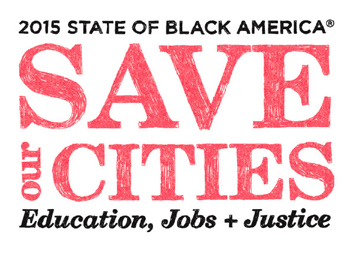State of Black America remains largely unchanged
By Askia Muhammad -Senior Editor- | Last updated: Mar 25, 2015 - 8:30:22 AMWhat's your opinion on this article?

|
“I must use the word crisis. Crisis, we face a crisis,” said Marc Morial, president and chief executive of the National Urban League said at a news conference March 19, where the organization released the “2015 State of Black America” report.
“Few times in a nation’s history is its collective conscience shocked and awakened across racial, economic, generational and even ideological lines as ours has been over the past year,” said Mr. Morial, in a statement. “We are in that moment, and as long as justice is challenged on any front, we will keep pushing on every front.”
The standard of living for a Black person, according to Mr. Morial, is 72 percent of the standard of living for the average White person. In terms of economics, health care and social justice, American society remains “a tale of two cities,” he continued.
The report has been issued annually for 39 years, uses calculations called an equality index to gauge the standard of living in the United States for different ethnic and racial groups. The city with the lowest Black median income in the country is Toledo, at $21,699. But the disparities are glaring, even in the affluent national capital region, which logged the highest median income for Blacks.
The median income for Blacks in the DMV (District of Columbia, Maryland, Virginia) is $64,663, the report said, while the median income for Whites—the highest in the country for that group as well—is $108,254. The national median Black income is $35,000 versus $58,000 for Whites, and the Black unemployment rate is more than double the rate for Whites.
The report notes that despite the recent spike of several murders and beatings of unarmed Black men and boys, especially at the hands of law enforcement officials resulting in a “challenge on every front,” social justice for Blacks is improving, with an overall reduction of crime and violence.
“The world watched as non-indictments of the police officers responsible for the deaths of unarmed Black males including Eric Garner, Michael Brown and John Crawford signaled that police accountability for taking Black lives was reaching a modern-day low,” the report said.
In response, activists and organizations across the country called for reforms in the justice system. A Department of Justice (DOJ) investigation into the Ferguson Police Department in Missouri following Mr. Brown’s killing found that racial bias against Blacks was endemic among law enforcement and that city’s courts.
Besides being disproportionately targeted by police, African Americans witnessed the erosion of voting rights in some states in 2014. Attorney General Eric Holder, in comments in Selma, Alabama, to commemorate the 1965 voting rights march, said that protections gained by the Civil Rights Movement are “under siege.”
“Fair and free access to the franchise is still, in some areas, under siege,” Mr. Holder said. “Shortly after the historic election of President Obama in 2008, numerous states and jurisdictions attempted to impose rules and laws that had the effect of restricting American’s opportunities to vote—particularly, and disproportionately, communities of color.”
The report also added that Blacks are twice as likely to live in poverty as are Whites. Blacks have a median wealth of $6,314 versus Whites who have $110,500, according to the report. This means the median African-American household has 6 cents in wealth for every dollar of White household wealth.
“On average, larger gaps were present in states with large urban areas that are home to large minority populations living in highly segregated neighborhoods with high rates of concentrated high poverty,” the report said.
INSIDE STORIES AND REVIEWS
-
-
About Harriett ... and the Negro Hollywood Road Show
By Rabiah Muhammad, Guest Columnist » Full Story -
Skepticism greets Jay-Z, NFL talk of inspiring change
By Bryan 18X Crawford and Richard B. Muhammad The Final Call Newspaper @TheFinalCall » Full Story -
The painful problem of Black girls and suicide
By Charlene Muhammad -National Correspondent- » Full Story -
Exploitation of Innocence - Report: Perceptions, policies hurting Black girls
By Charlene Muhammad -National Correspondent- » Full Story -
Big Ballin: Big ideas fuel a father’s Big Baller Brand and brash business sense
By Bryan Crawford -Contributing Writer- » Full Story






 Click Here Stay Connected!
Click Here Stay Connected!








